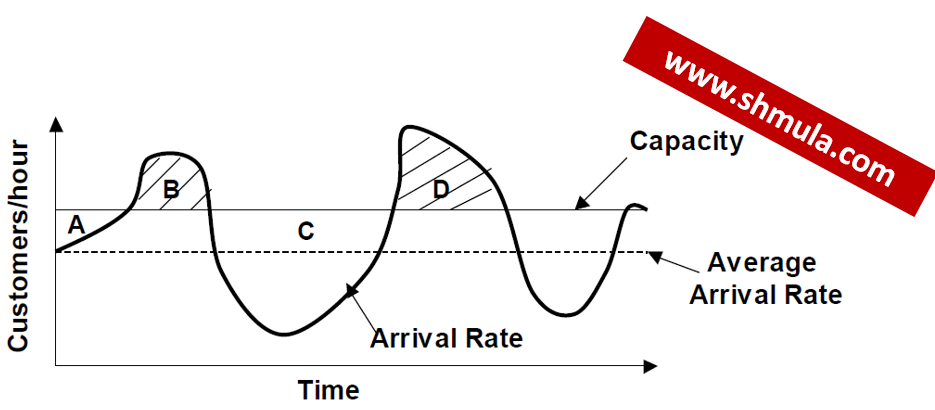This article is on the Practical Applications of Queueing Theory and how some of the assumptions of Queueing Theory can break down, necessitating the need for government intervention.
Queueing Theory is based on several assumptions. One of those assumptions is that when demand exceeds capacity, the result will be waiting lines. Often in situations where demand exceeds the capacity, we can either create more capacity and/or eliminate any waste at the point of constraint in the system. Let’s explore some basics on why, exactly, do we wait at all.
Why Do We Wait?
Consider the figure below:

In most operations, capacity is actually constant. A factory can only have so many machines; an airline can have so many flight attendants; a grocery store can have so many cash registers. Not only is it constant, but there’s also an upper limit to capacity – a ceiling. Now, let’s go back to the figure.
- During the period A and C, capacity exceeds the arrival rate of customers.
- So, any customer that arrives and is served between periods B and D, will increase the length of the line and the average waiting time.
- Conclusion: The average utilization of this operation is less than 100% because the average arrival rate is lower than capacity, yet customers experience a waiting time greater than zero. Why? Because of the “lumpiness” of the arrival rate – natural variation in the system.
In some cases, adding more capacity has a low cost. For example, opening up cash registers at a supermarket has a low relative cost. On the other hand, adding more doctors to relieve the waiting time at an emergency room has a relatively high cost attached to it.
What about reducing or eliminating waste at the constraint? Often times, this also has a relatively low cost – if there is adequate training in lean methods, root cause analysis, and a decent understanding of systems thinking, most anyone can eliminate or reduce waste at a bottleneck in the system.
But, what if there is available capacity, but they are not marshaled or deployed by choice?
That’s exactly what is happening at supermarkets in Venezuela [1. http://panampost.com/belen-marty/2014/08/22/got-shortages-chavistas-sic-operation-queue-killer-on-cash-registers/].
Operation Queue Killer
The Venezuelan government has launched a new initiative they call “Operation Queue Killer”, or Eficiencia Mata Cola in Spanish. In an audit of 66 private supermarkets, the investigators claim that more than half had at least one defective cash register. While others had fully functioning cash registers, but management chose not to open them. Both of these root causes lead to longer lines and longer waiting time.
The investigation doesn’t call out specifically, but there’s an undertone in the article that points to unfair pricing that are the result of fabricated demand, evidenced by the long waiting lines. Operation Queue Killer has one goal, according to Mendez, the Superintendent of Fair Prices:
Protect the sustenance of the Venezuelan Family
Continuing, Mendez claims the following:
When we conducted a thorough examination of why people are waiting in line, the phenomenon that drew our attention the most was that inspected supermarkets had more than half of their cash registers closed. Some even had 81 percent of their registers closed, and people waiting in line for three hours.
It seems to me that if there is truly widescale collusion, and shopkeepers are fabricating scarcity in order to drive up prices, it probably makes sense that the government is stepping in. To a queueing theorist, however, this is very interesting because this is one of the rare cases where factory physics aren’t the only things we are dealing with – now it’s human intervention.








No responses / comments so far.